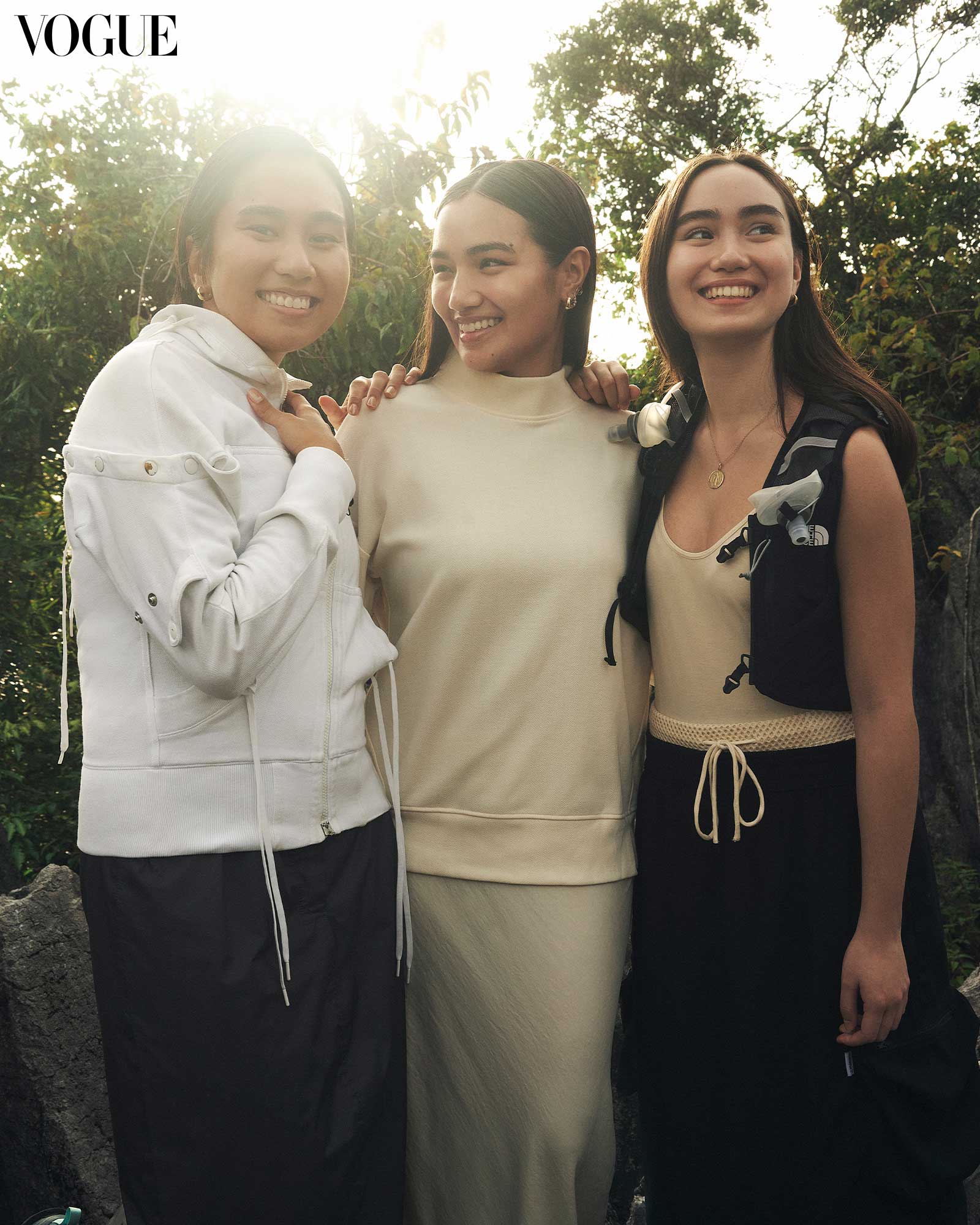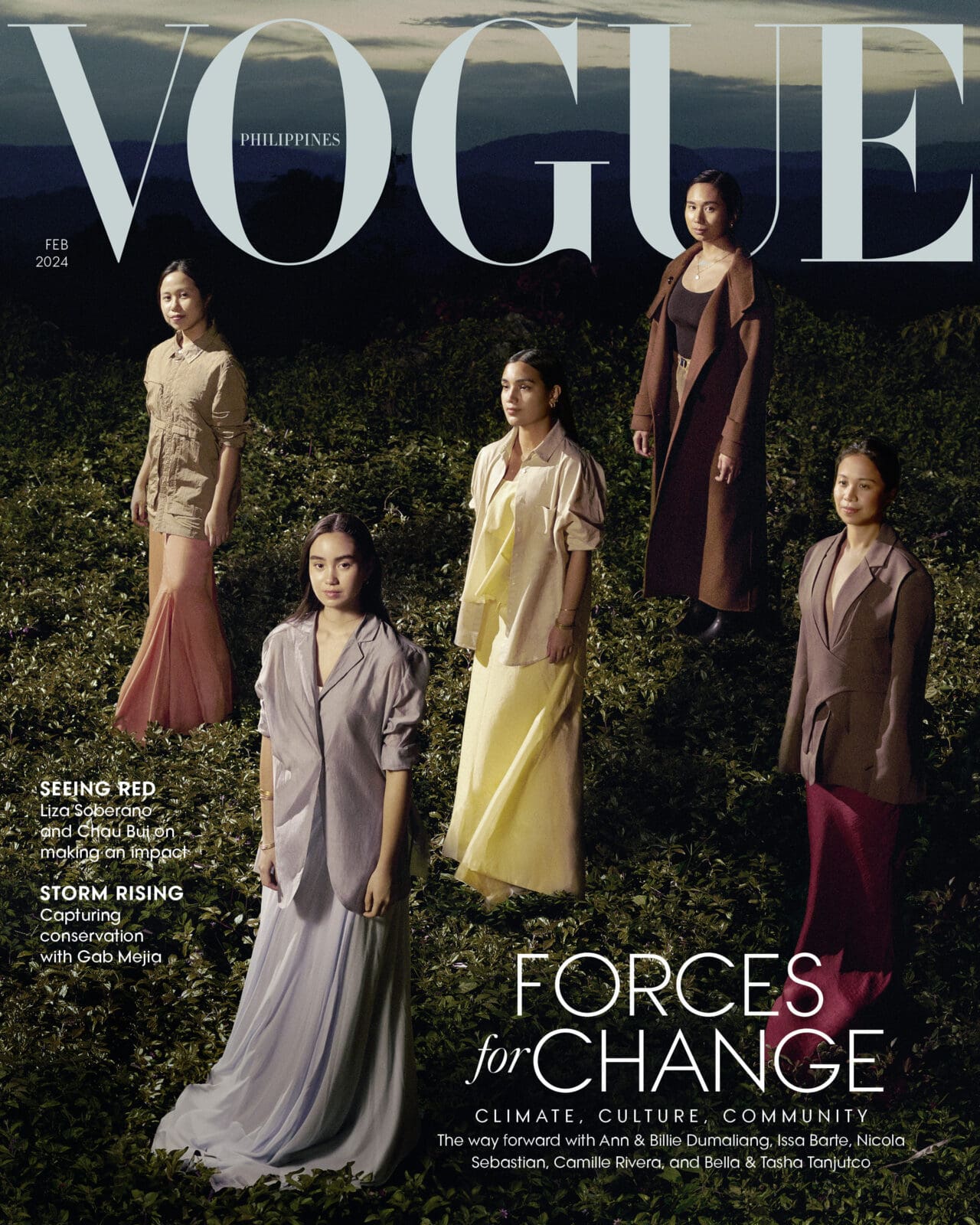Tasha wears a MOON RIVER top, APARA maxi skirt, SALOMON sneakers at R.O.X. Bella wears HINDY WEBER net skirt. Photographed by Artu Nepomuceno for the February 2024 Issue of Vogue Philippines
History, culture, and creativity. For Tasha and Bella Tanjutco, these three things can spark change and design solutions to global challenges.
Malikhain, the Tagalog word for creative, is a trait that has propelled Filipino talents to flourish worldwide, whether it be in art, music, fashion, or other creative fields. It is how we celebrate our culture, heritage, and identity. Still, creativity can do so much more for TAYO Philippines co-founders Tasha and Bella Tanjutco.
For these two young designers and storytellers, creativity is the means to redesign and redefine current systems to address global issues. In an exclusive interview with Vogue Philippines, Tasha and Bella Tanjutco opened up about nurturing creativity, the value of culture and history, and creating change through design solutions.

A unique upbringing
“Within childhood, you establish certain traits, abilities, and imagination that people will carry with them until they’re older. So a lot of the things that we end up doing when we are older are the things that give us joy and purpose,” says Tasha. “Our childhood made us see these were the opportunities that we had that not a lot of kids had, and that a lot of kids that have privilege don’t realize their privilege to be able to do more things.”
There is no denying that creativity runs in their blood. Their mother, Bambi Mañosa-Tanjutco, is an artist through and through. In raising Bella and Tasha, she encouraged them to experiment with their creativity and imagination. “Being an art teacher, she wasn’t afraid of us getting messy with the paint or anything. She allowed us to let our imagination flow,” says Bella.
“Our mom was a lot about creativity and free-flowing. She wanted us to appreciate the beauty of the world. And at the same time, my dad was in advertising, and his father and mother were both journalists before,” Tasha adds. “The realities are always so evident to us at the same time. We had this interesting balance growing up of knowing the reality that we needed to face and that these realities could improve if we first understood the beauty of the Earth.”
At nine years old, Bella and Tasha would accompany their mother during art therapy sessions with women who were victims of abuse. Witnessing these women heal through art, the two sisters saw how creativity and art can be used “as a tool to bring justice to a lot of people.”

This experience was not their only exposure to the world’s harsh realities. Aside from their mother, their father and grandparents never avoided discussing these hard truths. Through the power of storytelling, Bella and Tasha’s minds were informed about complex topics. “There was always time to make kuwento (to tell stories),” Tasha says. “There was always storytelling going on over Sunday lunch. Since my lola (grandmother) grew up during the war, we had a grasp on all these stories about injustice and colonization early on.”
Reflecting on the stories they listened to as kids, Bella and Tasha also emphasize the role of history in being creative. “If you understand the culture of your country or where you come from, your origins or your history, you can find purpose in what previous generations were already fighting for,” Bella shares. “To generate creativity or stay inspired, we can look at memories and channel forward something new.”
She continues, “The world is circular. Things come back, and that’s one thing that will help us continue using creativity as a tool to create change. It’s simply by understanding our culture and not being afraid to find purpose in it.”
Beyond listening to stories, their family has also allowed them to witness these hard truths first-hand. “They would show us the realities of the communities. As much as you feel much is given, much is also expected. That means if you’re born with a lot of privilege, you have to acknowledge it. And you must also give back and share your blessings,” Bella says.
All these things combined have led Tasha and Bella to pursue the path of creating change. “We grew up innately knowing that Filipino culture and doing things for the country’s benefit is important. And that was integrated into our minds at such a young age. If you do something good, it should be giving back to your country,” says Bella.

Creativity and design as a solution
Having grown up with an imagination that has no limits, Tasha and Bella never held back with their advocacies. “When we started our youth organization in 2015, many adults always asked us, ‘What do you want to change?’ And we’d always tell them, ‘Everything,'” Tasha shares. This answer would prompt adults to shake their heads at them, but Tasha and Bella believed in their vision.
She continues, “‘That’s not the thing,’ they would say. ‘You have to pick one’ or ‘Why don’t you outline the issues you want to tackle through the SDGs?’ But that wasn’t how we understood the way our Earth worked. We understood that at an early age, we were talking about systems transformation through creative solutions, and creativity not just the arts or music, but creativity being the human capacity to use our imagination.”
Bella and Tasha believe that creativity and design are the solutions to many problems the world faces today, even climate change. “The climate crisis is interconnected with everything around us and boils down to the relationship between humans and nature,” Tasha says. “Creativity is the solution because it teaches you what it means to be human.”
At present, Tasha and Bella continue to champion and nurture their creativity. “We’re honing our passion to do it for a purpose that transcends. For service and redesigning systems,” Bella shares.
“Anyone can be creative,” Tasha says. “Everyone is naturally creative, especially Filipinos. Within our culture, we are good at making things through our hands with weaving, crafting, building, and even thinking of ideas.”
- A Lifetime Of Growing And Protecting Forests: Ann And Billie Dumaliang On Their Ongoing Battle For Conservation At Masungi Georeserve
- Issa Barte On Amplifying Indigenous Voices And The Role Of Culture In Climate Action
- Camille Rivera On Bringing Life Back To Communities Through Mangrove Conservation
- Riding Waves, Growing Stories: Nicola Sebastian’s Path To Climate Justice In The Philippines

